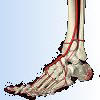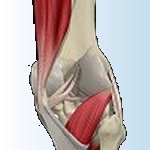

Injuries can be classified in two basic categories: traumatic injuries and overuse injuries.
Traumatic injuries are sudden happenings, in which you know something has gone wrong, and you feel the immediate effects of the injury, perhaps pain, swelling, bruising, or an open wound. The traumatic injury can be extrinsic, or due to some external cause, like a direct blow, a sudden twist as you change direction, or a fall. It can also be intrinsic, without an obvious cause, like the sprinter's sudden hamstring strain in a race, or the squash player's Achilles tendon rupture.
On the other hand, overuse injuries are more subtle, because they come on simply as a gradually increasing pain, directly associated with a particular, usually repetitive activity. Tennis elbow and runner's shin soreness are examples of overuse injuries.
Injuries do happen in various parts of the body. Below are the common injuries that could happen to an isolated part of the body:
1. Foot and Ankle
Ankle sprains.
Sprained ankles are one of the most common injuries in sports. Because the
inner ankle is more stable than the outer ankle, the foot is likely to turn
inward (ankle inversion) from a fall, tackle, or jump. This stretches or tears
ligaments; the result is an ankle sprain. The lateral ligament on the outer
ankle is most prone to injury.
Achilles tendon injury. The strongest and largest tendon, the Achilles tendon connects muscles in the lower leg with the hell bone. Sports that tighten the calf muscles can overstress this tendon and cause a strain (Achilles tendinitis) or a rupture. A direct blow to the foot, ankle, or calf can also cause it.
Overuse injuries. Excessive training, such as running long distances without rest, places repeated stress on the foot and ankle. The result can be stress fractures and muscle/tendon strains.
Shin splints. Pain in front of the shin bone usually is caused by a stress fracture, called shin splints. Overtraining, poorly fitting athletic shoes, and a change in running surface from soft to hard puts athletes at risk for this injury.
2. Heat Injury
Athletes participating in sports events or practice sessions during intense heat are the most suspectible to heat injury. Athletes who do not drink enough fluids during the intense heat also are prone to heat injury.
There are many forms of heat injury. The mildest form of heat injury is heat cramps which occurs when athletes do not drink enough fluids when exercising. Heat exhaustion is a more serious injury, triggered by excessive sweating and inadequate fluid replacement; the body is unable to supply the increased blood volume needed by the brain, skin and the muscles in extreme heat. Symptoms of heat injury are dizziness, weakness and fainting.
The most serious form of heat injury is the life-threatening heatstroke. Heatstroke occurs when the body's sweating mechanism shuts down, the skin become hot and dry, and the body is depleted of fluids.
3. Knee
Anterior Cruciate Ligament. Changing or twisting direction rapidly, slowing down when running, and landing from a jump are often the causes of tears in the ACL.
Medial Collateral
Ligament. Injuries to the MCL usually are caused by contact on the outside
of the knee. 
Posterior Cruciate Ligament. The PCL can be injured during sports activity when the athlete receives a blow to the front of the knee or makes a simple misstep on the playing field.
Torn knee cartilage is experienced by many people. When people talk about torn knee cartilage, they usually are referring to a torn meniscus. The meniscus is a tough, rubbery cartilage that is attached to the knee's ligaments. It acts like a shock absorber.
4. Shoulder
Instability. Sometimes, one of the shoulder joints moves or is forced out of its normal position. This condition is called instability, and can result in a dislocation of one of the joints in the shoulder. Individuals suffering from an instability problem will experience pain when they raise their arm. They also may feel as if their shoulder is slipping out of place.
Impingement. Impingement is caused by excessive rubbing of the rotator cuff and the top part of your shoulder blade called the acromion. Impingement problems can be sustained when participating in a sports activity that requires excessive overhead motion. If you do not seek medical care for the inflammation in your shoulder, it could eventually lead to amore serious injury. The rotator cuff is one of the most important components of the shoulder. It is comprised of a group of muscles and tendons that hold the shoulder joint in place. The rotator cuff provides individuals with the ability to lift their arm and reach overhead. If injured, it can become difficult for people to recover the full shoulder function needed to properly participate in the sports activity.